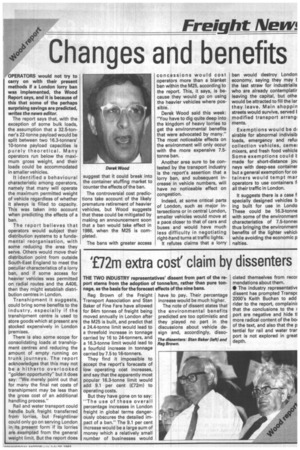0 Changes and benefits
Page 11

If you've noticed an error in this article please click here to report it so we can fix it.
OPERATORS would not try to carry on with their present methods if a London lorry ban was implemented, the Wood Report says, and it is because of this that some of the perhaps surprising savings are predicted,
writes the news editor.
The report says that, with the exception of some bulk loads, the assumption that a 32.5-tonner's 22-tonne payload would be split between two 16.3-tanners' 10-tonne payload capacities is purely theoretical. Many operators run below the maximum gross weight, and their loads could be accommodated in smaller vehicles.
It identified a behavioural characteristic among operators, namely that many will operate the maximum permitted weight of vehicle regardless of whether it always is filled to capacity. This was taken into account when predicting the effects of a ban.
The report believes that operators would subject their distribution systems to a fundamental reorganisation, with some reducing the area they serve. Others would move their distribution point from outside South-East England to meet the peculiar characteristics of a lorry ban, and if some access for heavier vehicles was permitted on radial routes and the A406, then they might establish distribution centres in London.
Transhipment it suggests, could bring some benefits to the industry, especially if the transhipment centre is used to store goads which at present are stocked expensively in London Premises.
There is also some scope for consolidating loads at transhipment centres and reducing the amount of empty running on trunk journeys. The report acknowledges that this may not be a hitherto overlooked "golden opportunity" but it does say: "We merely point out that for many the final net costs of transhipment may be less than the gross cost of an additional handling process."
Rail and water transport could handle bulk freight transferred from lorries, but Freightliner could only go on serving London in its present form if its lorries are exempted from the general weight limit. But the report does The controversial cost predictions take account of the likely premature retirement of heavier vehicles, but Wood suggests that these could be mitigated by making an announcement soon that a ban would take effect in 1986, when the M25 is completed. concessions would cost operators more than a blanket ban within the M25, according to the report. This, it says, is because they would go on using the heavier vehicles where possible.
Derek Wood said this week: "You have to dig quite deep into the kingdom of heavy lorries to get the environmental benefits that were advocated by many." The most noticeable effects on the environment will only occur with the more expensive 7.5tonne ban.
Another area sure to be contested by the transport industry is the report's assertion that a lorry ban, and subsequent increase in vehicle numbers, will have no noticeable effect on congestion.
Indeed, at some critical parts of London, such as major intersections or in central London, smaller vehicles would move at a pace closer to that of cars and buses and would have much less difficulty in negotiating right-hand turns at traffic lights.
It refutes claims that a lorry ban would destroy London economy, saying they may t the last straw for industrialis who are already contemplatir leaving the capital, but othe would be attracted to fill the lar they leave. Main shoppin streets would survive, served t modified transport arrangi ments.
Exemptions would be di sirable for abnormal indivisib loads, emergency and refur collection vehicles, cemei mixers, and fresh food vehicle Some exemptions could t made for short-distance jou neys with deep-sea container but a general exemption for co tainers would tempt mar operators to use containers f all their traffic in London.
It suggests there is a case f specially designed vehicles b ing built for use in Londo These could be 16.3-tonne with some of the environment characteristics of 7.5-tonner thus bringing the environment benefits of the lighter vehicli while avoiding the economic p nalties.




















































































